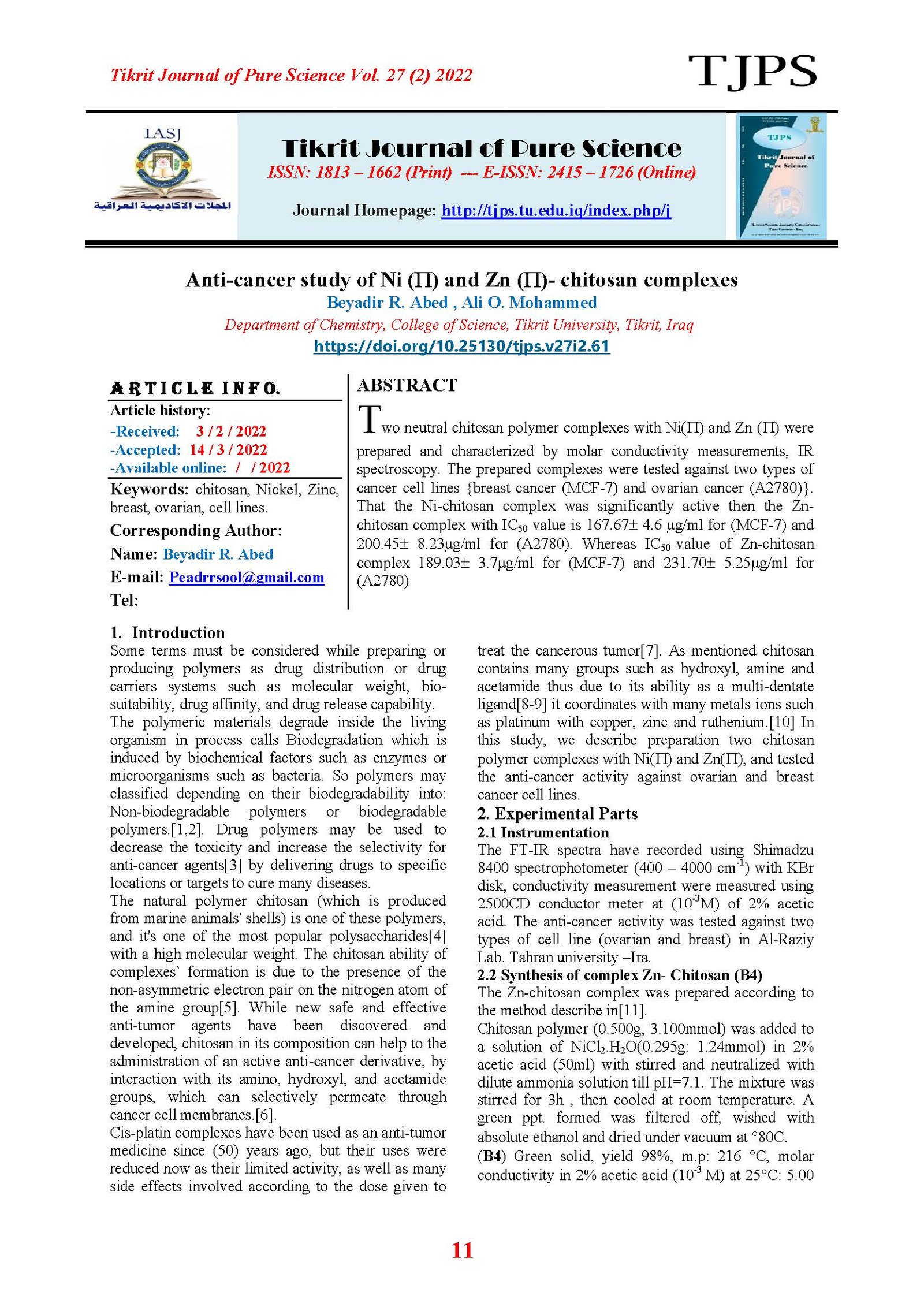Anti-cancer study of Ni (II) and Zn (II)- chitosan complexes
Main Article Content
Abstract
Two neutral chitosan polymer complexes with Ni(II) and Zn (II) were prepared and characterized by molar conductivity measurements, IR spectroscopy. The prepared complexes were tested against two types of cancer cell lines {breast cancer (MCF-7) and ovarian cancer (A2780)}. That the Ni-chitosan complex was significantly active then the Zn-chitosan complex with IC50 value is 167.67± 4.6 mg/ml for (MCF-7) and 200.45± 8.23mg/ml for (A2780). Whereas IC50 value of Zn-chitosan complex 189.03± 3.7mg/ml for (MCF-7) and 231.70± 5.25mg/ml for (A2780)
Article Details

This work is licensed under a Creative Commons Attribution 4.0 International License.
Tikrit Journal of Pure Science is licensed under the Creative Commons Attribution 4.0 International License, which allows users to copy, create extracts, abstracts, and new works from the article, alter and revise the article, and make commercial use of the article (including reuse and/or resale of the article by commercial entities), provided the user gives appropriate credit (with a link to the formal publication through the relevant DOI), provides a link to the license, indicates if changes were made, and the licensor is not represented as endorsing the use made of the work. The authors hold the copyright for their published work on the Tikrit J. Pure Sci. website, while Tikrit J. Pure Sci. is responsible for appreciate citation of their work, which is released under CC-BY-4.0, enabling the unrestricted use, distribution, and reproduction of an article in any medium, provided that the original work is properly cited.
References
[1] Manavitehrani I., Fathi A., Badr H., Daly S., Negahi Shirazi, A., and Dehghani F. (2016). Biomedical applications of biodegradable polyesters. Polymers, 8(1), 20.
[2] Ikada Y., and Tsuji H. (2000). Biodegradable polyesters for medical and ecological applications. Macromolecular rapid communications, 21(3), 117-132.
[3] Cohen D. S., and Erneux T. (1998). Controlled drug release asymptotics. SIAM Journal on Applied Mathematics, 58(4), 1193-1204.
[4] Ramya R., Sudha P. N., and Mahalakshmi J. (2012). Preparation and characterization of chitosan binary blend. Int. J. Sci. Res. Publ, 2(10), 1-9.
[5] Muzzarelli R. A., Tanfani F., Mariotti S., and Emanuelli M. (1982). Preparation and characteristic properties of dithiocarbamate chitosan, a chelating polymer. Carbohydrate Research, 104(2), 235-243.
[6] Ramya R., Sudha P. N., and Mahalakshmi J. (2012). Preparation and characterization of chitosan binary blend. Int. J. Sci. Res. Publ, 2(10), 1-9.
[7] Fuertes M. A., Alonso C., and Pérez J. M. (2003). Biochemical modulation of cisplatin mechanisms of action: enhancement of antitumor activity and circumvention of drug resistance. Chemical reviews, 103(3), 645-662.
[8] Arkenau H. T., Carden C. P., and de Bono J. S. (2008). Targeted agents in cancer therapy. Medicine, 36(1), 33-37.
[9] Hannon M. J. (2007). Metal-based anticancer drugs: From a past anchored in platinum chemistry to a post-genomic future of diverse chemistry and biology. Pure and Applied Chemistry, 79(12), 2243-2261.
[10] Kalinowska-Lis U., Ochocki J., and Matlawska-Wasowska K. (2008). Trans geometry in platinum antitumor complexes. Coordination Chemistry Reviews, 252(12-14), 1328-1345.
[11] Zheng Y., Yi, Y., Qi Y., Wang Y., Zhang W., and Du M. (2006). Preparation of chitosan–copper complexes and their antitumor activity. Bioorganic and medicinal chemistry letters, 16(15), 4127-4129.
[12] Geary W. J. (1971). The use of conductivity measurements in organic solvents for the characterisation of coordination compounds. Coordination Chemistry Reviews, 7(1), 81-122. [13] Al‐Janabi, A. S., Zaky, R., Yousef, T. A., Nomi, B. S., & Shaaban, S. (2020). Synthesis, characterization, computational simulation, biological and anticancer evaluation of Pd (II), Pt (II), Zn (II), Cd (II), and Hg (II) complexes with 2‐amino‐4‐phenyl‐5‐selenocyanatothiazol ligand. Journal of the Chinese Chemical Society, 67(6), 1032-1044.
[14] Al‐Janabi, A. S., Saleh, A. M., & Hatshan, M. R. (2021). Cytotoxicity, anti‐microbial studies of M (II)‐dithiocarbamate complexes, and molecular docking study against SARS COV2 RNA‐dependent RNA polymerase. Journal of the Chinese Chemical Society, 68(6), 1104-1115.
[15] Beck W. (1988). K. Nakamoto: Infrared and Raman Spectra of Inorganic and Coordination Compounds, 4. Auflage, John Wiley and Sons, New York, Chichester, Brisbane, Toronto, Singapore 1986.
[16] Hughes M. N., and Rutt K. J. (1972). Complexes of thiazoles. Part IV. Acetamido-thiazoles as ambidentate ligands. Journal of the Chemical Society, Dalton Transactions, (13), 1311-1313.
[17] Varma A. J., Deshpande S. V., and Kennedy J. F. (2004). Metal complexation by chitosan and its derivatives: a review. Carbohydrate polymers, 55(1), 77-93.
[18] Murphy M. P. (2009). How mitochondria produce reactive oxygen species. Biochemical journal, 417(1), 1-13.
[19] Sugano M., Fujikawa T., Hiratsuji Y., Nakashima K., Fukuda N., and Hasegawa Y. (1980). A novel use of chitosan as a hypocholesterolemic agent in rats. The American Journal of Clinical Nutrition, 33(4), 787-793.
[20] Hasegawa M., Yagi K., Iwakawa S., and Hirai, M. (2001). Chitosan induces apoptosis via caspase‐3 activation in bladder tumor cells. Japanese journal of cancer research, 92(4), 459-466.
[21] Qi L., Xu Z., and Chen M. (2007). In vitro and in vivo suppression of hepatocellular carcinoma growth by chitosan nanoparticles. European journal of cancer, 43(1), 184-193.
[22] Ai J. W., Liao W., and Ren Z. L.(2017). Enhanced anticancer effect of copper-loaded chitosan nanoparticles against osteosarcoma. RSC advances, 7(26), 15971-15977. [23] Al‐Janabi, A. S., Saleh, A. M., & Hatshan, M. R. (2021). Cytotoxicity, anti‐microbial studies of M (II)‐dithiocarbamate complexes, and molecular docking study against SARS COV2 RNA‐dependent RNA polymerase. Journal of the Chinese Chemical Society, 68(6), 1104-1115.
[24] Faihan, A. S., Hatshan, M. R., Alqahtani, A. S., Nasr, F. A., Al-Jibori, S. A., & Al-Janabi, A. S. (2022). New divalent metal ion complexes with 1, 8-diaminonapthalene-2-thione: Synthesis, Spectroscopic, anti-bacterial and anticancer activity studies. Journal of Molecular Structure, 1247, 131291.
[25] Al-Janabi, A. S., Alheety, M. A., Osama'a, A. Y., Shaaban, S., Kibar, B., & Cacan, E. (2020). Anti-cancer and anti-fungal evaluation of novel palladium (II) 1-phenyl-1H-tetrazol-5-thiol complexes. Inorganic Chemistry Communications, 121, 108193.
